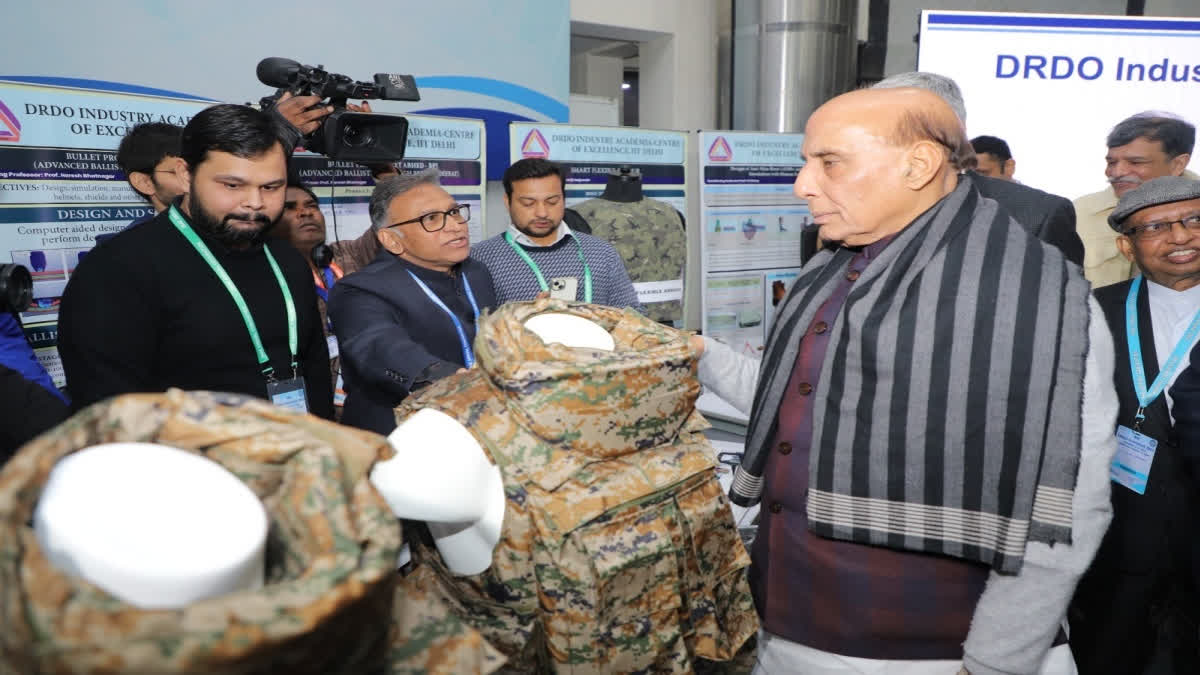New Delhi: In a significant stride toward self-reliance in defence technology, the DRDO Industry Academia-Centre of Excellence (DIA-CoE) at IIT Delhi is spearheading a wave of innovation designed to equip Indian armed forces with cutting-edge indigenous solutions. With a steadfast commitment to enhancing national security, DIA-CoE has been instrumental in addressing critical defence needs through collaborative research involving IIT Delhi, DRDO laboratories, and Indian industries. Defence Minister Rajnath Singh graced the inaugural session.
Dr Samir V Kamat, Secretary of Defence R&D and Chairman of DRDO, highlighted the transformative potential of these initiatives. Speaking exclusively to ETV Bharat, he remarked, “The bullet-proof jackets currently in use by the armed forces weigh over 10.5 kilograms for level-five protection. Through our collaboration with IIT Delhi, we have developed a lightweight jacket that weighs only 8.2 kilograms, saving over two kilograms of weight. This reduction significantly eases the operational burden on soldiers during missions.”
He further emphasised the export potential of such innovations, stating, “Once these jackets are mass-produced, they will not only be cost-competitive but will also outperform global alternatives in terms of weight and protection. This achievement opens up tremendous opportunities for both domestic deployment and international exports.”
A Game-Changer for Soldiers
The lightweight bulletproof jacket, developed as part of DIA-CoE’s projects, is among the most promising breakthroughs. Dr Hemant Chouhan, an associate professor at IIT Delhi and the lead developer of the jacket, shared insights into its design and significance.
“In 2016, the standard bulletproof jackets weighed over 10.4 kilograms. Our new jacket reduces the weight by more than 25%, achieving a weight of 8.2 kilograms,” Dr. Chouhan said. “This was a monumental achievement, but we have continued to innovate. Recently, we developed a sniper-resistant jacket weighing 9.5 kilograms, capable of stopping six sniper rounds, a standard unmatched globally. The Indian Army’s requirements are rigorous, demanding protection against multiple sniper shots, and we have successfully met this challenge.”
The advanced jacket is designed to provide comprehensive protection, including coverage for the throat, groin, and sides, making it ideal for high-risk operations. Rigorous testing by DRDO’s Chandigarh-based lab has validated the jacket’s performance, marking a significant milestone in its journey toward mass production.
Impact on Operational Efficiency
The lighter and more advanced jackets are expected to significantly enhance soldiers’ mobility and endurance, particularly in extreme terrains and combat scenarios. By reducing the physical strain on personnel, these innovations align with the evolving demands of modern warfare, where agility and speed are critical.
Dr Chouhan elaborated, “The weight reduction directly translates to increased operational efficiency for our soldiers. Carrying a lighter jacket allows them to focus more on the mission and less on the equipment burden. Moreover, the indigenous development ensures that these products are tailored to the specific needs of the Indian Army.”
Expanding the Scope of Indigenous Defence Technology
The bulletproof jacket is just one of many groundbreaking projects under DIA-CoE’s umbrella. With over 30 active projects addressing various defence needs, the centre is making strides in areas such as Smart Soldier Jackets: Integrated with advanced sensors for real-time monitoring.
Terahertz Technology: For the spectroscopy and imaging of energetic materials.
Technology Transfer and Industrial Collaboration
The recent signing of multiple Memorandums of Agreement (MoAs) during the Annual Convention of the Indian National Academy of Engineering (INAE) at IIT Delhi marked a significant step in taking these innovations to the production stage. The lightweight bulletproof jacket codenamed ABHED (Advanced Ballistic High Energy Defeat), has been transferred to leading Indian firms such as Mishra Dhatu Nigam (MIDHANI), SMPP Pvt Ltd, and AR Polymers (MKU).
Dr Kamat stressed the importance of industrial collaboration: “Mass production by private industries will bring down costs and ensure timely availability of these technologies to our armed forces. This collaboration is a testament to the potential of public-private partnerships in defence.”
Path to Self-Reliance (Atma Nirbhar Bharat)
The focus on indigenous development not only addresses strategic defence needs but also reduces dependency on imports. According to Dr. Chouhan, “Currently, many critical defence materials are imported, adding to costs and limiting customization. By producing these technologies in India, we not only reduce costs but also build a robust ecosystem that can support future innovations.”
The Indigenous development of defence solutions also has the potential to benefit civilian applications. For instance, cold-weather jackets developed for soldiers could be adapted for use by civilians in extreme climates, and firefighter suits could improve safety standards for emergency responders.
The Road Ahead
The journey of DIA-CoE has been marked by relentless dedication from nearly 100 faculty members, 200 research scholars, and countless staff members at IIT Delhi. Their collaborative efforts are not only advancing the defence sector but also contributing to India’s vision of becoming a global leader in technology and innovation.
Dr Chouhan concluded with a vision for the future: “We are constantly working to push the boundaries of what is possible. With each product, we aim to improve performance, reduce costs, and enhance the safety and efficiency of our soldiers. As our defence minister also said to further reduce the weight, our next steps will involve further weight reduction and the integration of smart technologies.”
As India continues its journey toward self-reliance, the innovations emerging from DIA-CoE underscore the critical role of collaboration between academia, industry, and government. By equipping the armed forces with advanced, home-grown technologies, India is not only strengthening its defence capabilities but also setting the stage for global leadership in defence innovation.
Key Collaborations and Agreements
ABHED Bulletproof Jackets transferred to MIDHANI, SMPP Pvt Ltd, and AR Polymers.
Development of polymeric ballistic materials with Reliance Industries.
Limited series production of extreme cold-weather gear with Aeronav Industrial Safety Appliance and others.
Production of extreme heat protective clothing with Arrow Garments and Katalyst TECHTEX.
With the successful development and transfer of advanced defence technologies, DIA-CoE and its partners are redefining India’s defence landscape. From enhancing soldier safety to fostering self-reliance, these initiatives stand as a testament to India’s capability to innovate and lead on the global stage.



